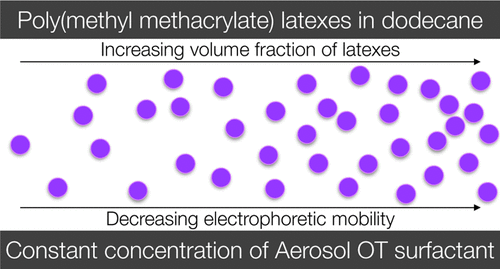Our official English website, www.x-mol.net, welcomes your
feedback! (Note: you will need to create a separate account there.)
Charging Poly(methyl Methacrylate) Latexes in Nonpolar Solvents: Effect of Particle Concentration
Langmuir ( IF 3.7 ) Pub Date : 2017-11-15 00:00:00 , DOI: 10.1021/acs.langmuir.7b02257 Gregory N. Smith 1 , Silvia Ahualli 2 , Ángel V. Delgado 2 , David A. J. Gillespie 1 , Roger Kemp 3 , Jocelyn Peach 1 , Jonathan C. Pegg 1 , Sarah E. Rogers 4 , Olga Shebanova 5 , Nathan Smith 3 , Julian Eastoe 1
Langmuir ( IF 3.7 ) Pub Date : 2017-11-15 00:00:00 , DOI: 10.1021/acs.langmuir.7b02257 Gregory N. Smith 1 , Silvia Ahualli 2 , Ángel V. Delgado 2 , David A. J. Gillespie 1 , Roger Kemp 3 , Jocelyn Peach 1 , Jonathan C. Pegg 1 , Sarah E. Rogers 4 , Olga Shebanova 5 , Nathan Smith 3 , Julian Eastoe 1
Affiliation

|
The electrophoresis of a well-established model system of charged colloids in nonpolar solvents has been studied as a function of particle volume fraction at constant surfactant concentration. Dispersions of poly(12-hydroxystearic acid)-stabilized poly(methyl methacrylate) (PMMA) latexes in dodecane were prepared with added Aerosol OT surfactant as the charging agent. The electrophoretic mobility (μ) of the PMMA latexes is found to decrease with particle concentration. The particles are charged by a small molecule charging agent (AOT) at finite concentration, and this makes the origin of this decrease in μ unclear. There are two suggested explanations. The decrease could either be due to the reservoir of available surfactant being exhausted at high particle concentrations or the interactions between the charged particles at high particle number concentrations. Contrast-variation small-angle neutron scattering measurements of PMMA latexes and deuterated AOT-d34 surfactant in latex core contrast-matched solvent were used to study the former, and electrokinetic modeling was used to study the latter. As the same amount of AOT-d34 is found to be incorporated with the latexes at all volume fractions, the solvodynamic and electrical interactions between particles are determined to be the explanation for the decrease in mobility. These measurements show that, for small latexes, there are interactions between the charged particles at all accessible particle volume fractions and that it is necessary to account for this to accurately determine the electrokinetic ζ potential.
中文翻译:

在非极性溶剂中带电聚甲基丙烯酸甲酯乳液:颗粒浓度的影响
在恒定的表面活性剂浓度下,已经研究了建立完善的非极性溶剂中带电胶体模型系统的电泳与颗粒体积分数的关系。加入Aerosol OT表面活性剂作为填充剂,制备聚(12-羟基硬脂酸)稳定的聚(甲基丙烯酸甲酯)(PMMA)胶乳在十二烷中的分散体。发现PMMA胶乳的电泳迁移率(μ)随颗粒浓度而降低。粒子由小分子带电剂(AOT)以有限的浓度带电,这使得μ减小的原因不清楚。有两种建议的解释。减少可能是由于在高颗粒浓度下耗尽了可用的表面活性剂库,或者是由于在高颗粒数浓度下带电颗粒之间的相互作用。PMMA乳胶和氘化AOT-的对比变化小角中子散射测量d 34乳胶芯对比剂中的表面活性剂用于前者研究,电动力学模型用于后者。由于发现所有体积分数的胶乳中都掺入了相同量的AOT- d 34,因此确定颗粒之间的溶剂动力学和电相互作用是迁移率降低的解释。这些测量结果表明,对于较小的胶乳,带电粒子之间在所有可访问的粒子体积分数处都有相互作用,因此必须考虑到这一点才能准确确定电动ζ电势。
更新日期:2017-11-16
中文翻译:

在非极性溶剂中带电聚甲基丙烯酸甲酯乳液:颗粒浓度的影响
在恒定的表面活性剂浓度下,已经研究了建立完善的非极性溶剂中带电胶体模型系统的电泳与颗粒体积分数的关系。加入Aerosol OT表面活性剂作为填充剂,制备聚(12-羟基硬脂酸)稳定的聚(甲基丙烯酸甲酯)(PMMA)胶乳在十二烷中的分散体。发现PMMA胶乳的电泳迁移率(μ)随颗粒浓度而降低。粒子由小分子带电剂(AOT)以有限的浓度带电,这使得μ减小的原因不清楚。有两种建议的解释。减少可能是由于在高颗粒浓度下耗尽了可用的表面活性剂库,或者是由于在高颗粒数浓度下带电颗粒之间的相互作用。PMMA乳胶和氘化AOT-的对比变化小角中子散射测量d 34乳胶芯对比剂中的表面活性剂用于前者研究,电动力学模型用于后者。由于发现所有体积分数的胶乳中都掺入了相同量的AOT- d 34,因此确定颗粒之间的溶剂动力学和电相互作用是迁移率降低的解释。这些测量结果表明,对于较小的胶乳,带电粒子之间在所有可访问的粒子体积分数处都有相互作用,因此必须考虑到这一点才能准确确定电动ζ电势。











































 京公网安备 11010802027423号
京公网安备 11010802027423号